|


Art in
the 19th Century Punjab
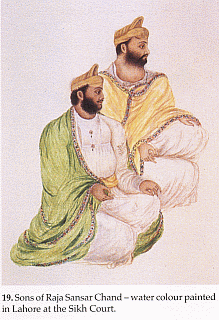 During
the 17th, 18th and even the 19th century the appreciation of any art
produced in the Punjab has been reserved for the paintings produced in the
Punjab Hill States. The condition of the arts is largely dependant upon
the political and social conditions in the area. A. R. Chughtai1 insists
that the Hill States and their Rajas were not secure or prosperous enough
to have provided much patronage to any artists of the late nineteenth and
twentieth century. He asserts that he himself, with his younger brother
Abdur Rahim Chughtai travelled extensively in the Hill States in 1929 but
failed to find any evidence of patronage for the artists. He quotes one
artist, Hazuri, who told Chughtai that the Pahari artist and state
patronage had been a myth and that most of the Pahari Rajas did not have
the means to employ artists for art activity. Hazuri claimed that the
artists infact earned their living from farming and produced the paintings
in their spare time. If there had been state patronage, he argued, a lot
more paintings would have been found in the possession of the Rajas. The
few paintings found with the Rajas had been taken in lieu of taxes which
the poor farmers could not pay. This practice was witnessed by Hazuri when
his own father was subjected to it. During
the 17th, 18th and even the 19th century the appreciation of any art
produced in the Punjab has been reserved for the paintings produced in the
Punjab Hill States. The condition of the arts is largely dependant upon
the political and social conditions in the area. A. R. Chughtai1 insists
that the Hill States and their Rajas were not secure or prosperous enough
to have provided much patronage to any artists of the late nineteenth and
twentieth century. He asserts that he himself, with his younger brother
Abdur Rahim Chughtai travelled extensively in the Hill States in 1929 but
failed to find any evidence of patronage for the artists. He quotes one
artist, Hazuri, who told Chughtai that the Pahari artist and state
patronage had been a myth and that most of the Pahari Rajas did not have
the means to employ artists for art activity. Hazuri claimed that the
artists infact earned their living from farming and produced the paintings
in their spare time. If there had been state patronage, he argued, a lot
more paintings would have been found in the possession of the Rajas. The
few paintings found with the Rajas had been taken in lieu of taxes which
the poor farmers could not pay. This practice was witnessed by Hazuri when
his own father was subjected to it.
While considering Chughtai's views one should also perhaps keep in mind J.
P. VogerV account of his tour of the Kangra district.
"In 1905 when I was making a tour in the Kangra district after the
earthquake of the 4th April, Pandit Hirananda Sastri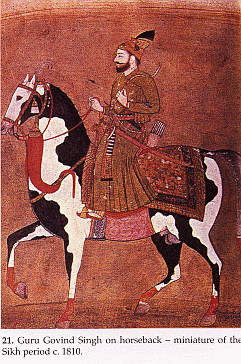 who was then my assistant, had the good fortune to fall in with a man who
proved to be a descendant of one of Sansar Chand's court painters. The
poor man, whom his native hills offered no scope for the exercise of his
ancestral art, hoped to find employment at the court of one of the petty
Rajas in Jammu and Kashmir. He was still in possession of a number of
drawings which were damaged by insects and bore the evident marks of
prolonged neglect. He was ready to part with them and I'm sure that by
purchasing them, we have saved the collection from destruction."
who was then my assistant, had the good fortune to fall in with a man who
proved to be a descendant of one of Sansar Chand's court painters. The
poor man, whom his native hills offered no scope for the exercise of his
ancestral art, hoped to find employment at the court of one of the petty
Rajas in Jammu and Kashmir. He was still in possession of a number of
drawings which were damaged by insects and bore the evident marks of
prolonged neglect. He was ready to part with them and I'm sure that by
purchasing them, we have saved the collection from destruction."
This episode as quoted by F. S. Aijazuddin,3 as well as Chughtai's
experience seem to point out and strengthen the theory that Pahari
painting under the patronage of the Rajas ceased to exist by the time of
the Dogra invasion in 1808. The hill state artists found patronage in the
court of Lahore from where they spread out to all the smaller courts in
the second half of the nineteenth century. We already have records of
various Pahari artists working in several places in the Punjab plains as
court artists of the princely states. There was Parkhu from Kangra who
worked in Lahore around 1820 (See Appendix II, No. 4). Then there was Devi
Ditta who was working in Lahore and Patiala in 1865 (See Appendix II, No.
52). There was Professor Khanda (Abdullah) Khan who came from Jammu (See
Appendix II, No. 1). There was also Basharat Ullah who was a student of
Parkhu and worked in the Pahari tradition in the court of Patiala as well
as in Lahore in 1825 (See Appendix II, No. 9). "With the Sikh kingdom at
Lahore establishing its supremacy, some of Pahari painters from Guler
migrated to Lahore to enjoy the patronage of Maharaja Ranjeet Singh and
his sardars. Among these painters was Nikka, third son of Nainsukh, who
had for some time worked at Chamba. He received a grant of land from
Maharaja Ranjeet Singh in 1825. Gokal, Chajju, Harkhu and Damodar were
other artists who worked for Sikh patrons. Chajju painted portraits of
Sikh nobles.... who were employed as high officials by the Lahore
darbar."4
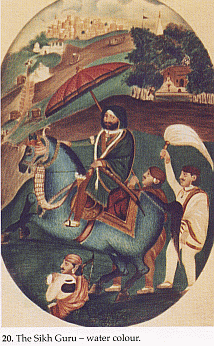 Srivastava,5
Sohan Lai Suri6 and A. R. Chughtai7 have all insisted that the painting
which flourished at Lahore under Maharaja Ranjeet Singh (1799-1839) was
the work of local artists and not a mere extension of Pahari painting.
Aryan8 in his book Punjab Painting however remarks "On the 'dead blank' of
the arts in the Punjab plains, there are hardly any indications to show
the actual condition of pictorial art in the Punjab immediately preceding
the Sikh period." Aryan's contention as well as that of others that Pahari
painting is the only worthwhile painting from the Punjab before during and
after the Sikh rule, should be re-examined so that Pahari and non-Pahari
painting in the Punjab is properly perceived and evaluated. Uptil now very
few scholars have paid attention to painting in the Punjab plains. It
would be fruitful to research the subject in greater depth, keeping in
mind that the Hill State artists were not a permanent entity in the Hill
States especially after the Dogra invasion in 1808. They kept coming and
going and were willing to supply their beautiful miniatures and painting
skill to anyone who was willing to acquire them or learn from them. Srivastava,5
Sohan Lai Suri6 and A. R. Chughtai7 have all insisted that the painting
which flourished at Lahore under Maharaja Ranjeet Singh (1799-1839) was
the work of local artists and not a mere extension of Pahari painting.
Aryan8 in his book Punjab Painting however remarks "On the 'dead blank' of
the arts in the Punjab plains, there are hardly any indications to show
the actual condition of pictorial art in the Punjab immediately preceding
the Sikh period." Aryan's contention as well as that of others that Pahari
painting is the only worthwhile painting from the Punjab before during and
after the Sikh rule, should be re-examined so that Pahari and non-Pahari
painting in the Punjab is properly perceived and evaluated. Uptil now very
few scholars have paid attention to painting in the Punjab plains. It
would be fruitful to research the subject in greater depth, keeping in
mind that the Hill State artists were not a permanent entity in the Hill
States especially after the Dogra invasion in 1808. They kept coming and
going and were willing to supply their beautiful miniatures and painting
skill to anyone who was willing to acquire them or learn from them.
At the time Chughtai travelled in the Hill States, the conditions were as
uncertain as anywhere else and whatever patronage or peace of mind the
artists might have had in the past in these small havens, had long since
vanished. The same is also true of artists working at the court of Delhi
for whom the short Sikh monarchy provided a breathing space of stability
and encouraged them to settle in the Punjab. They received considerable
encouragement during the Ranjeet Singh era and also during the few years
of Sher Singh's rule.
The appreciation and quest for Pahari painting was a wave that surfaced in
the early twentieth century. At that time there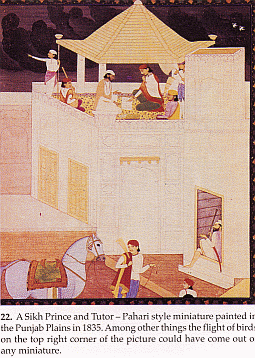 was no evidence of any patronage of art in the Punjab Hill States. The old
Pahari pictures may have created the market, but there is every
possibility that the continuous demand that had been generated was met by
the painters of Lahore and Amritsar or even Patiala and Kapurthala. The
quantity and quality of work produced in the plains was certainly of a
calibre that could easily satisfy this increasing interest. We can see
from the pictures reproduced (see Fig. 19 to 23, page 33-34) that the
finest qualities of Pahari art were evident in paintings that were made in
the court at Lahore. These paintings were done in Lahore around 1835 and
testify to the merit of the art work being done here before the advent of
the British.
was no evidence of any patronage of art in the Punjab Hill States. The old
Pahari pictures may have created the market, but there is every
possibility that the continuous demand that had been generated was met by
the painters of Lahore and Amritsar or even Patiala and Kapurthala. The
quantity and quality of work produced in the plains was certainly of a
calibre that could easily satisfy this increasing interest. We can see
from the pictures reproduced (see Fig. 19 to 23, page 33-34) that the
finest qualities of Pahari art were evident in paintings that were made in
the court at Lahore. These paintings were done in Lahore around 1835 and
testify to the merit of the art work being done here before the advent of
the British.
A book titled Le Songe d'un habitant du Mogol recently published by the
French Government in 1989 as a mark of friendship for the Indian
Government has provided concrete proof of the excellent work done in the
Punjab in the 19th century. This book is full of illustrations of the
fables written by the French writer Jean De La Fountaine. In the early
19th century these fables were printed in such a way that blank sheets
were left with each fable which were sent out all over the world to be
illustrated in the traditional painting style of that area.
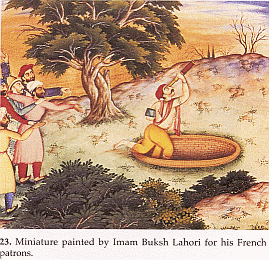 These
sheets were also sent to the French Generals who were working for Ranjeet
Singh in the Punjab at that time. These Generals even though based in the
Punjab, had access to information from other cultural centres in India and
it can be safely stated that if there was anyone doing better painting
anywhere else in the subcontinent, they would have known about it. It
would also have been quite practical for them to commission the 59
illustrations and ask the artists to come and live in Lahore or Attock
(\vhere the paintings were done) till the assignment was complete. The
fact that they chose Imam Buksh from Lahore to handle the work speaks
volumes for the kind of work that was being done in Lahore. When we look
at these illustrations, some of them are as good as paintings done at any
time in the subcontinent (see Fig. 23, page 34). These
sheets were also sent to the French Generals who were working for Ranjeet
Singh in the Punjab at that time. These Generals even though based in the
Punjab, had access to information from other cultural centres in India and
it can be safely stated that if there was anyone doing better painting
anywhere else in the subcontinent, they would have known about it. It
would also have been quite practical for them to commission the 59
illustrations and ask the artists to come and live in Lahore or Attock
(\vhere the paintings were done) till the assignment was complete. The
fact that they chose Imam Buksh from Lahore to handle the work speaks
volumes for the kind of work that was being done in Lahore. When we look
at these illustrations, some of them are as good as paintings done at any
time in the subcontinent (see Fig. 23, page 34).
This French book now reveals the paintings that had been lost to the
public view and lends an insight into the state of painting in the Punjab
plains which has been neglected for much too long. Moreover it is also
important because it is in keeping with the local tradition of book
illustration. Through this we gain information about one artist. There
must have been many more about whom we know very little, and whose work
cannot be identified because they have not been signed. Historians also
mention other painters who were painting as well as Imam Buksh around the
same period but no importance has been given to them by art critics due to
the lack of enough pictorial evidence. One thing we can say with some
certainty, that the quality and standard of work being produced in the
Punjab, both in the Pahari as well as the Mughal miniature tradition, was
admirable when there was a proper patronage for it.
Ranjeet Singh and his nobles were good patrons but their appreciation
extended primarily to commissioning of their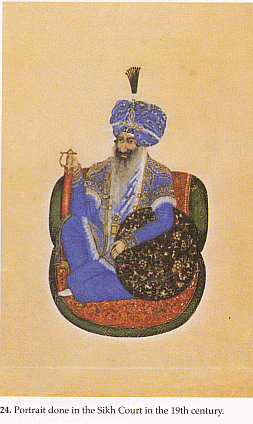 portraits and pictures on religious themes and some court scenes (see page
34). Ranjeet Singh himself however was a reluctant model because of his
one blind eye. F. S. Aijazuddin9 quotes Vigne,1" the British geographer,
who in 1837 persistently tried to draw Ranjeet Singh - "by persevering in
my request, Ranjeet at length allowed me to attempt his portrait in full
darbar. When I first asked him I was at Lahore, in company with Baron
Hugel. He coloured, smiled and replied, 'Tomorrow at Amritsar' which was
only an oriental mode of refusing, as he had no idea of going to Amritsar.
I again respectfully urged the request, 'No! No!' he said, 'I am an old
man.' Take his picture/ pointing to Heera Singh; 'he is young and
handsome"'. Vigne then goes on to say about his portrait "Had I been
obsequious enough to have given Ranjeet two eyes, he would probably have
made no objection, and when he did sit to me, he was constantly turning
away so as to conceal his blind side." In fact, it is an oft quoted fact
that very few painters dared to paint Ranjeet Singh's blind eye during his
lifetime. However during the British rule when Ranjeet Singh, having
resisted the British became a legendary hero, people painted his blind eye
and made a virtue out of it.
portraits and pictures on religious themes and some court scenes (see page
34). Ranjeet Singh himself however was a reluctant model because of his
one blind eye. F. S. Aijazuddin9 quotes Vigne,1" the British geographer,
who in 1837 persistently tried to draw Ranjeet Singh - "by persevering in
my request, Ranjeet at length allowed me to attempt his portrait in full
darbar. When I first asked him I was at Lahore, in company with Baron
Hugel. He coloured, smiled and replied, 'Tomorrow at Amritsar' which was
only an oriental mode of refusing, as he had no idea of going to Amritsar.
I again respectfully urged the request, 'No! No!' he said, 'I am an old
man.' Take his picture/ pointing to Heera Singh; 'he is young and
handsome"'. Vigne then goes on to say about his portrait "Had I been
obsequious enough to have given Ranjeet two eyes, he would probably have
made no objection, and when he did sit to me, he was constantly turning
away so as to conceal his blind side." In fact, it is an oft quoted fact
that very few painters dared to paint Ranjeet Singh's blind eye during his
lifetime. However during the British rule when Ranjeet Singh, having
resisted the British became a legendary hero, people painted his blind eye
and made a virtue out of it.
At the court of Ranjeet Singh there were local as well as Pahari artists
working along with European painters. Paqir Syed Wahid-ud-Din,n the great
grandson of Faqir Aziz-ud-Din, who was a minister of Ranjeet Singh,
mentions the artists Kehar Singh, Muhammad Buksh and Parkhu of Kangra at
Ranjeet Singh's court. During the Mughal and Sikh rule artists were given
hujras or rooms in the Wazir Khan Mosque where among others, lived people
like Baba Miran Baksh, who excelled in music as well as painting. He died
in 1920.
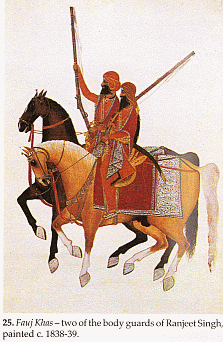 A
large number of European travellers who were artists also visited the
Lahore Court during the Sikh period. It should be remembered, however,
that the influence of European art had already started during Emperor
Akbar's reign. At that time, even though there were some direct attempts
to copy European paintings, stylistically the local artists were not
impressed, yet there were a few subtle changes which grew with the passage
of time. Although the general aspect and subject matter of the paintings
remained there was a marked effort on the part of the local artists to
depict spacial as well as linear perspective. A
large number of European travellers who were artists also visited the
Lahore Court during the Sikh period. It should be remembered, however,
that the influence of European art had already started during Emperor
Akbar's reign. At that time, even though there were some direct attempts
to copy European paintings, stylistically the local artists were not
impressed, yet there were a few subtle changes which grew with the passage
of time. Although the general aspect and subject matter of the paintings
remained there was a marked effort on the part of the local artists to
depict spacial as well as linear perspective.
Information about these and other European artists who came later, as well
as the Punjab artists who painted during the hundred years (1849-1947) is
listed in Appendices I and II.
The British, when they heard of the excellent reputation of Ranjeet
Singh's army sought every opportunity or made any excuse to visit the
Lahore Court. That is how British amateurs like Emily Eden, Francis Eden,
Carter, Harcourt, Edwards, Osborne and Vigne came to the Lahore Court.
They observed, sketched, painted and recorded facts that would be of
interest to the military strategists back in Delhi. J. M. Lafont,12 the
French scholar, very aptly describes the visit of a British contingent:
"But the British Government wanted to know more about the Punjab and
particularly about this French Legion which seemed to be at least equal to
the best troops of the East India Company. They made use of the occasion
of a complimentary mission sent by Ranjeet Singh to Simla, to despatch
Captain Wade to Lahore on a return mission in May 1827. No need to explain
the instructions provided to the clever political officer." And then again
in the same booklet, J. M. Lafont, describing the marriage of Ranjeet
Singh's grandson Nao Nihal Singh, writes "The Governor General could not
come, but the Com-mander-in-Chief, the old and experienced Lord Fane,
came, with a good number of inquisitive officers." Many of these
'inquisitive officers and their wives or sisters produced drawings and
paintings that fill 57 folios in the India Office Library.
The French and the Italian influence came with General Allarde and General
Ventura who built the effective special army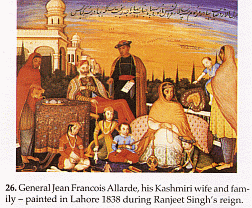 unit, Fauj-i-Khas, in Ranjeet Singh's army (see page 34). Both of them had
accompanied Napoleon in his European battles (Allarde is said to have gone
to Russia with Napoleon's army). They managed to come to the Punjab from
the Persian route in spite of the efforts of the British to keep them out
of India. They reached Shahdara in March 1822 and by May 1822, Ranjeet
Singh had put a Sikh Battalion under them. Allarde was incharge of the
cavalry and Ventura incharge of the infantry. These officers stayed with
Ranjeet Singh for seventeen years. It was during this time that one of
these officers commissioned Imam Buksh to illustrate Jean de la Fontaine
legends.
unit, Fauj-i-Khas, in Ranjeet Singh's army (see page 34). Both of them had
accompanied Napoleon in his European battles (Allarde is said to have gone
to Russia with Napoleon's army). They managed to come to the Punjab from
the Persian route in spite of the efforts of the British to keep them out
of India. They reached Shahdara in March 1822 and by May 1822, Ranjeet
Singh had put a Sikh Battalion under them. Allarde was incharge of the
cavalry and Ventura incharge of the infantry. These officers stayed with
Ranjeet Singh for seventeen years. It was during this time that one of
these officers commissioned Imam Buksh to illustrate Jean de la Fontaine
legends.
In 1827 these two officers were joined by Court and Avitable and given
command of regular brigades. Court was French and an expert on artillery
and shell production. Avitable like Ventura was Italian and an able
administrator.
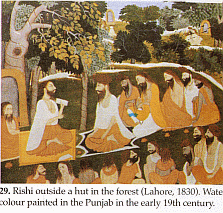 Old
British journals and travellers mention the wall paintings in houses owned
or occupied by Europeans. Masson13 describes the Italian general
Avitable's house with its murals which he saw at Lahore when he was
staying with Allarde. W. Barr14 describes Allarde's house at the time of
the general's funeral "- we went to Allarde's country house where his body
was lying in state. The residence is decorated inside and out with
paintings of dragoons, foot soldiers and lancers, half as large as life.
The wide verandahs have the same display of paintings. Allarde's portrait
bespeaks him as a man of firmness, decision of character, and a handsome
and benevolent man. In another picture were the pretty faces of his
Kashmiri wife and children". G. T. Vigne also described the mural
paintings at Wazirabad. Some other murals in European houses were located
at: Old
British journals and travellers mention the wall paintings in houses owned
or occupied by Europeans. Masson13 describes the Italian general
Avitable's house with its murals which he saw at Lahore when he was
staying with Allarde. W. Barr14 describes Allarde's house at the time of
the general's funeral "- we went to Allarde's country house where his body
was lying in state. The residence is decorated inside and out with
paintings of dragoons, foot soldiers and lancers, half as large as life.
The wide verandahs have the same display of paintings. Allarde's portrait
bespeaks him as a man of firmness, decision of character, and a handsome
and benevolent man. In another picture were the pretty faces of his
Kashmiri wife and children". G. T. Vigne also described the mural
paintings at Wazirabad. Some other murals in European houses were located
at:
- Avitable's house in Wazirabad;
- Allarde's house at Wazirabad;
- Allarde and Ventura's house in Anarkali; and
- Allarde's garden house beyond Anarkali (the Chief Secretary's
office now).
Since Ranjeet Singh was in supreme command of nearly all of the Punjab,
the small Sikh states of the Malwa region on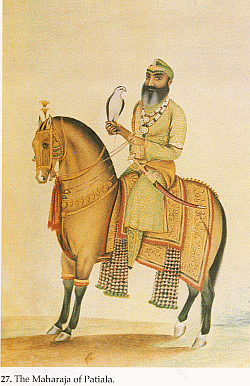 the east of the Sutlej (also called the Cis-Sutlej and the Phulkian
states) aligned themselves with Delhi. The rulers of these small states or
principalities like Patiala, Kapurthala, Jind, Nabha, Faridkot, Kalsia,
Nalagarh and Malerkotla which were part of the Phulkian states, had
enjoyed full regal rights and privileges during the last two hundred
years. Patiala was the oldest and most powerful of these. The founding
father of this principality had helped the Mughals against the Afghan
invasion while the later princes aligned themselves with the British in
order to retain their rule.
the east of the Sutlej (also called the Cis-Sutlej and the Phulkian
states) aligned themselves with Delhi. The rulers of these small states or
principalities like Patiala, Kapurthala, Jind, Nabha, Faridkot, Kalsia,
Nalagarh and Malerkotla which were part of the Phulkian states, had
enjoyed full regal rights and privileges during the last two hundred
years. Patiala was the oldest and most powerful of these. The founding
father of this principality had helped the Mughals against the Afghan
invasion while the later princes aligned themselves with the British in
order to retain their rule.
Most of these ruler were educated and influenced by the western style of
life (see page 35). They patronised the arts and copied many of the
successful local styles of architecture as well as painting. Raja Narinder
Singh (1845-62) of Patiala for instance, constructed a Moti Bagh Palace on
the pattern of the Shalimar Gardens of Lahore. Raja Jagjit Singh of
Kapurthala constructed a court hall resembling the High Court of Lahore.
Raja Raghbir Singh of Jheend constructed markets on the pattern of Jaipur.
Similarly they patronised painting, music and poetry as well as the living
artists. They had murals painted in palaces as well as public buildings in
the well-known styles of Mughal and Pahari miniatures.
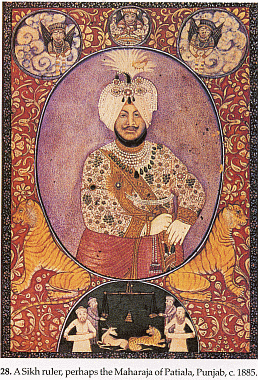 This
patronage enabled the artists to continue with painting like their
forefathers had done. Even though they did not produce anything original,
this provided them respite after fleeing from the strife of the Hill
States of the Punjab or the turmoil of the post Ranjeet Singh period in
Lahore. Thus when the British entered the Punjab they found an art
tradition rich with Mughal precision imbued with Pahari romance, pushed
into perspective with European influences (see page 35-36). Yet they felt
they could teach the natives a thing or two when they surveyed the scene
through their monocles. This
patronage enabled the artists to continue with painting like their
forefathers had done. Even though they did not produce anything original,
this provided them respite after fleeing from the strife of the Hill
States of the Punjab or the turmoil of the post Ranjeet Singh period in
Lahore. Thus when the British entered the Punjab they found an art
tradition rich with Mughal precision imbued with Pahari romance, pushed
into perspective with European influences (see page 35-36). Yet they felt
they could teach the natives a thing or two when they surveyed the scene
through their monocles.
Lord Baden Powel15 writing about the arts of the Punjab, sums up their
general attitude, "Native artists are quite wanting in any sympathy with
Nature or Love of beauty for its own sake." However, he goes on to admit
that, "Natives seem to have quite an instinct for colour without the
faintest idea of the theory of light and its composition or the rules
about complimentary colours". Quite a dampening attitude, for as it was,
even the most enthusiastic artist had to struggle against innumerable odds
just to keep up with the bare cost of living. Needless to say, this
attitude could not have encouraged him to go on painting. But one thing is
certain and various writers16 have testified that Lahore was full of
artists, when the British arrived on the scene, and they awaited their new
rulers with expectations and trepidations.

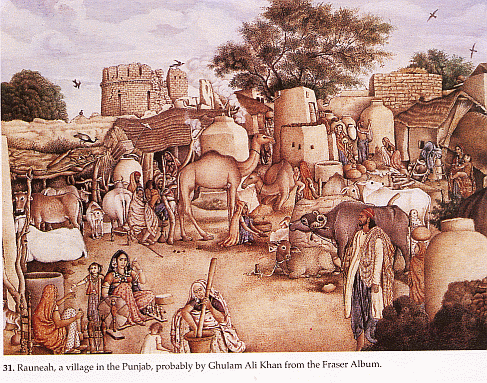
___________________________________________________________________________________________
REFERENCES
1
A. R. CHUGHTAI
-
Lahore Ka Dabistan-e-Musawari
(Urdu).
Lahore, 1979.
pp. 23-24.
2
J. P. VOGEL
-
History of Punjab Hill States,
Lahore, 1933, pp. 98 -198.
cf.
R S. Aijazuddin (from No. 3).
3 R S. AIJAZUDDIN
-
Pahari Painting and Sikh Portraits in
the
Lahore
Museum.
London,
1977. p. xx.
4
RANDHAVA M. S.
-
Indian Miniature Painting,
New Delhi, 1981.
5
SRIVASTAVA
- Punjab Painting. New Delhi,
1983, p. 11
"Patronage of Pine Arts under the
Sikh Rulers of the Pun
jab."
The Sikh Courier Vol. 7 No. 1,
London, 1973.
6 LALA SOHAN LAL SURI
- Umdatul Twarikh
(Persian - 5 volumes). Lahore, 1886.
Reprint New Delhi, 1961. Dafter IV,
Part II, p. 5.
7
A. R. CHUGHTAI
-
Lahore
Ka Dabistan-e-Musawari"
(Urdu)
Lahore, 1979.
pp. 33
- 38.
8
K. C. ARYAN
-
Hundred "Years Survey of Punjab
Painting.
New
Delhi,
1977, pp. 14 -15.
9
R S. AIJAZUDDIN
-
Pahari Painting and Sikh Portraits in
the
Lahore
Museum,
London, 1977, p.
XXVII.
10
VIGNE
-
Travels in
Kashmir, Lahore and Iskardu .
London, 1842.
p.
274.
11
R S. WAHEED-UD-DIN
-
The Real Ranjeet Singh.
Karachi, 1965, p. 121.
12
J. M. LAFONT
-
Military Activities of French
Officers of Maharaja Ranjeet
Singh.
Amritsar,
1982. p. 44 and p. 57.
13
MASSON
-
Journeys in
Ealochistan, Afghanistan and the Punjab,
London,
1842. p. 410.
14
W. BARR
-
Journal of a March.
London,
1844. p. 83. cf. C. Grey in Eu
ropean adventurers in Northern India,
1785
-1849, p. 92.
15
BADEN POWEL
-
Handbook of Manufactures and Arts of
the Punjab, La
hore, 1872. pp. 344 - 345.
16
Information about art activities in
the Punj ab can be col
lected from:-
(a)
VON ORLICH
Who was
present in the darbar of Sher Singh at
Lahore
and took notice of the presence of several
native
artists in "Travels in
India,
including Sind and
the
Punjab",
London,
1842/2 Volumes.
(b)
MAULVI AHMAD BAKSH YAKDIL
His 20
Volumes of diaries have a number of references
to artists living in Lahore during the Sikh
Rule.
c/A. R. Chughtai (no. 6).
(c)
SITA RAM KOHLI
Catalogue ofKhalsa Darbar Records Punjab,
Patiala 1928.
Kohli
was research student who worked with
Garrett
in the Punjab Archives on the Sikh Darbar
Records.
|

 During
the 17th, 18th and even the 19th century the appreciation of any art
produced in the Punjab has been reserved for the paintings produced in the
Punjab Hill States. The condition of the arts is largely dependant upon
the political and social conditions in the area. A. R. Chughtai1 insists
that the Hill States and their Rajas were not secure or prosperous enough
to have provided much patronage to any artists of the late nineteenth and
twentieth century. He asserts that he himself, with his younger brother
Abdur Rahim Chughtai travelled extensively in the Hill States in 1929 but
failed to find any evidence of patronage for the artists. He quotes one
artist, Hazuri, who told Chughtai that the Pahari artist and state
patronage had been a myth and that most of the Pahari Rajas did not have
the means to employ artists for art activity. Hazuri claimed that the
artists infact earned their living from farming and produced the paintings
in their spare time. If there had been state patronage, he argued, a lot
more paintings would have been found in the possession of the Rajas. The
few paintings found with the Rajas had been taken in lieu of taxes which
the poor farmers could not pay. This practice was witnessed by Hazuri when
his own father was subjected to it.
During
the 17th, 18th and even the 19th century the appreciation of any art
produced in the Punjab has been reserved for the paintings produced in the
Punjab Hill States. The condition of the arts is largely dependant upon
the political and social conditions in the area. A. R. Chughtai1 insists
that the Hill States and their Rajas were not secure or prosperous enough
to have provided much patronage to any artists of the late nineteenth and
twentieth century. He asserts that he himself, with his younger brother
Abdur Rahim Chughtai travelled extensively in the Hill States in 1929 but
failed to find any evidence of patronage for the artists. He quotes one
artist, Hazuri, who told Chughtai that the Pahari artist and state
patronage had been a myth and that most of the Pahari Rajas did not have
the means to employ artists for art activity. Hazuri claimed that the
artists infact earned their living from farming and produced the paintings
in their spare time. If there had been state patronage, he argued, a lot
more paintings would have been found in the possession of the Rajas. The
few paintings found with the Rajas had been taken in lieu of taxes which
the poor farmers could not pay. This practice was witnessed by Hazuri when
his own father was subjected to it. who was then my assistant, had the good fortune to fall in with a man who
proved to be a descendant of one of Sansar Chand's court painters. The
poor man, whom his native hills offered no scope for the exercise of his
ancestral art, hoped to find employment at the court of one of the petty
Rajas in Jammu and Kashmir. He was still in possession of a number of
drawings which were damaged by insects and bore the evident marks of
prolonged neglect. He was ready to part with them and I'm sure that by
purchasing them, we have saved the collection from destruction."
who was then my assistant, had the good fortune to fall in with a man who
proved to be a descendant of one of Sansar Chand's court painters. The
poor man, whom his native hills offered no scope for the exercise of his
ancestral art, hoped to find employment at the court of one of the petty
Rajas in Jammu and Kashmir. He was still in possession of a number of
drawings which were damaged by insects and bore the evident marks of
prolonged neglect. He was ready to part with them and I'm sure that by
purchasing them, we have saved the collection from destruction." Srivastava,5
Sohan Lai Suri6 and A. R. Chughtai7 have all insisted that the painting
which flourished at Lahore under Maharaja Ranjeet Singh (1799-1839) was
the work of local artists and not a mere extension of Pahari painting.
Aryan8 in his book Punjab Painting however remarks "On the 'dead blank' of
the arts in the Punjab plains, there are hardly any indications to show
the actual condition of pictorial art in the Punjab immediately preceding
the Sikh period." Aryan's contention as well as that of others that Pahari
painting is the only worthwhile painting from the Punjab before during and
after the Sikh rule, should be re-examined so that Pahari and non-Pahari
painting in the Punjab is properly perceived and evaluated. Uptil now very
few scholars have paid attention to painting in the Punjab plains. It
would be fruitful to research the subject in greater depth, keeping in
mind that the Hill State artists were not a permanent entity in the Hill
States especially after the Dogra invasion in 1808. They kept coming and
going and were willing to supply their beautiful miniatures and painting
skill to anyone who was willing to acquire them or learn from them.
Srivastava,5
Sohan Lai Suri6 and A. R. Chughtai7 have all insisted that the painting
which flourished at Lahore under Maharaja Ranjeet Singh (1799-1839) was
the work of local artists and not a mere extension of Pahari painting.
Aryan8 in his book Punjab Painting however remarks "On the 'dead blank' of
the arts in the Punjab plains, there are hardly any indications to show
the actual condition of pictorial art in the Punjab immediately preceding
the Sikh period." Aryan's contention as well as that of others that Pahari
painting is the only worthwhile painting from the Punjab before during and
after the Sikh rule, should be re-examined so that Pahari and non-Pahari
painting in the Punjab is properly perceived and evaluated. Uptil now very
few scholars have paid attention to painting in the Punjab plains. It
would be fruitful to research the subject in greater depth, keeping in
mind that the Hill State artists were not a permanent entity in the Hill
States especially after the Dogra invasion in 1808. They kept coming and
going and were willing to supply their beautiful miniatures and painting
skill to anyone who was willing to acquire them or learn from them. was no evidence of any patronage of art in the Punjab Hill States. The old
Pahari pictures may have created the market, but there is every
possibility that the continuous demand that had been generated was met by
the painters of Lahore and Amritsar or even Patiala and Kapurthala. The
quantity and quality of work produced in the plains was certainly of a
calibre that could easily satisfy this increasing interest. We can see
from the pictures reproduced (see Fig. 19 to 23, page 33-34) that the
finest qualities of Pahari art were evident in paintings that were made in
the court at Lahore. These paintings were done in Lahore around 1835 and
testify to the merit of the art work being done here before the advent of
the British.
was no evidence of any patronage of art in the Punjab Hill States. The old
Pahari pictures may have created the market, but there is every
possibility that the continuous demand that had been generated was met by
the painters of Lahore and Amritsar or even Patiala and Kapurthala. The
quantity and quality of work produced in the plains was certainly of a
calibre that could easily satisfy this increasing interest. We can see
from the pictures reproduced (see Fig. 19 to 23, page 33-34) that the
finest qualities of Pahari art were evident in paintings that were made in
the court at Lahore. These paintings were done in Lahore around 1835 and
testify to the merit of the art work being done here before the advent of
the British. These
sheets were also sent to the French Generals who were working for Ranjeet
Singh in the Punjab at that time. These Generals even though based in the
Punjab, had access to information from other cultural centres in India and
it can be safely stated that if there was anyone doing better painting
anywhere else in the subcontinent, they would have known about it. It
would also have been quite practical for them to commission the 59
illustrations and ask the artists to come and live in Lahore or Attock
(\vhere the paintings were done) till the assignment was complete. The
fact that they chose Imam Buksh from Lahore to handle the work speaks
volumes for the kind of work that was being done in Lahore. When we look
at these illustrations, some of them are as good as paintings done at any
time in the subcontinent (see Fig. 23, page 34).
These
sheets were also sent to the French Generals who were working for Ranjeet
Singh in the Punjab at that time. These Generals even though based in the
Punjab, had access to information from other cultural centres in India and
it can be safely stated that if there was anyone doing better painting
anywhere else in the subcontinent, they would have known about it. It
would also have been quite practical for them to commission the 59
illustrations and ask the artists to come and live in Lahore or Attock
(\vhere the paintings were done) till the assignment was complete. The
fact that they chose Imam Buksh from Lahore to handle the work speaks
volumes for the kind of work that was being done in Lahore. When we look
at these illustrations, some of them are as good as paintings done at any
time in the subcontinent (see Fig. 23, page 34). portraits and pictures on religious themes and some court scenes (see page
34). Ranjeet Singh himself however was a reluctant model because of his
one blind eye. F. S. Aijazuddin9 quotes Vigne,1" the British geographer,
who in 1837 persistently tried to draw Ranjeet Singh - "by persevering in
my request, Ranjeet at length allowed me to attempt his portrait in full
darbar. When I first asked him I was at Lahore, in company with Baron
Hugel. He coloured, smiled and replied, 'Tomorrow at Amritsar' which was
only an oriental mode of refusing, as he had no idea of going to Amritsar.
I again respectfully urged the request, 'No! No!' he said, 'I am an old
man.' Take his picture/ pointing to Heera Singh; 'he is young and
handsome"'. Vigne then goes on to say about his portrait "Had I been
obsequious enough to have given Ranjeet two eyes, he would probably have
made no objection, and when he did sit to me, he was constantly turning
away so as to conceal his blind side." In fact, it is an oft quoted fact
that very few painters dared to paint Ranjeet Singh's blind eye during his
lifetime. However during the British rule when Ranjeet Singh, having
resisted the British became a legendary hero, people painted his blind eye
and made a virtue out of it.
portraits and pictures on religious themes and some court scenes (see page
34). Ranjeet Singh himself however was a reluctant model because of his
one blind eye. F. S. Aijazuddin9 quotes Vigne,1" the British geographer,
who in 1837 persistently tried to draw Ranjeet Singh - "by persevering in
my request, Ranjeet at length allowed me to attempt his portrait in full
darbar. When I first asked him I was at Lahore, in company with Baron
Hugel. He coloured, smiled and replied, 'Tomorrow at Amritsar' which was
only an oriental mode of refusing, as he had no idea of going to Amritsar.
I again respectfully urged the request, 'No! No!' he said, 'I am an old
man.' Take his picture/ pointing to Heera Singh; 'he is young and
handsome"'. Vigne then goes on to say about his portrait "Had I been
obsequious enough to have given Ranjeet two eyes, he would probably have
made no objection, and when he did sit to me, he was constantly turning
away so as to conceal his blind side." In fact, it is an oft quoted fact
that very few painters dared to paint Ranjeet Singh's blind eye during his
lifetime. However during the British rule when Ranjeet Singh, having
resisted the British became a legendary hero, people painted his blind eye
and made a virtue out of it. A
large number of European travellers who were artists also visited the
Lahore Court during the Sikh period. It should be remembered, however,
that the influence of European art had already started during Emperor
Akbar's reign. At that time, even though there were some direct attempts
to copy European paintings, stylistically the local artists were not
impressed, yet there were a few subtle changes which grew with the passage
of time. Although the general aspect and subject matter of the paintings
remained there was a marked effort on the part of the local artists to
depict spacial as well as linear perspective.
A
large number of European travellers who were artists also visited the
Lahore Court during the Sikh period. It should be remembered, however,
that the influence of European art had already started during Emperor
Akbar's reign. At that time, even though there were some direct attempts
to copy European paintings, stylistically the local artists were not
impressed, yet there were a few subtle changes which grew with the passage
of time. Although the general aspect and subject matter of the paintings
remained there was a marked effort on the part of the local artists to
depict spacial as well as linear perspective. unit, Fauj-i-Khas, in Ranjeet Singh's army (see page 34). Both of them had
accompanied Napoleon in his European battles (Allarde is said to have gone
to Russia with Napoleon's army). They managed to come to the Punjab from
the Persian route in spite of the efforts of the British to keep them out
of India. They reached Shahdara in March 1822 and by May 1822, Ranjeet
Singh had put a Sikh Battalion under them. Allarde was incharge of the
cavalry and Ventura incharge of the infantry. These officers stayed with
Ranjeet Singh for seventeen years. It was during this time that one of
these officers commissioned Imam Buksh to illustrate Jean de la Fontaine
legends.
unit, Fauj-i-Khas, in Ranjeet Singh's army (see page 34). Both of them had
accompanied Napoleon in his European battles (Allarde is said to have gone
to Russia with Napoleon's army). They managed to come to the Punjab from
the Persian route in spite of the efforts of the British to keep them out
of India. They reached Shahdara in March 1822 and by May 1822, Ranjeet
Singh had put a Sikh Battalion under them. Allarde was incharge of the
cavalry and Ventura incharge of the infantry. These officers stayed with
Ranjeet Singh for seventeen years. It was during this time that one of
these officers commissioned Imam Buksh to illustrate Jean de la Fontaine
legends. Old
British journals and travellers mention the wall paintings in houses owned
or occupied by Europeans. Masson13 describes the Italian general
Avitable's house with its murals which he saw at Lahore when he was
staying with Allarde. W. Barr14 describes Allarde's house at the time of
the general's funeral "- we went to Allarde's country house where his body
was lying in state. The residence is decorated inside and out with
paintings of dragoons, foot soldiers and lancers, half as large as life.
The wide verandahs have the same display of paintings. Allarde's portrait
bespeaks him as a man of firmness, decision of character, and a handsome
and benevolent man. In another picture were the pretty faces of his
Kashmiri wife and children". G. T. Vigne also described the mural
paintings at Wazirabad. Some other murals in European houses were located
at:
Old
British journals and travellers mention the wall paintings in houses owned
or occupied by Europeans. Masson13 describes the Italian general
Avitable's house with its murals which he saw at Lahore when he was
staying with Allarde. W. Barr14 describes Allarde's house at the time of
the general's funeral "- we went to Allarde's country house where his body
was lying in state. The residence is decorated inside and out with
paintings of dragoons, foot soldiers and lancers, half as large as life.
The wide verandahs have the same display of paintings. Allarde's portrait
bespeaks him as a man of firmness, decision of character, and a handsome
and benevolent man. In another picture were the pretty faces of his
Kashmiri wife and children". G. T. Vigne also described the mural
paintings at Wazirabad. Some other murals in European houses were located
at: the east of the Sutlej (also called the Cis-Sutlej and the Phulkian
states) aligned themselves with Delhi. The rulers of these small states or
principalities like Patiala, Kapurthala, Jind, Nabha, Faridkot, Kalsia,
Nalagarh and Malerkotla which were part of the Phulkian states, had
enjoyed full regal rights and privileges during the last two hundred
years. Patiala was the oldest and most powerful of these. The founding
father of this principality had helped the Mughals against the Afghan
invasion while the later princes aligned themselves with the British in
order to retain their rule.
the east of the Sutlej (also called the Cis-Sutlej and the Phulkian
states) aligned themselves with Delhi. The rulers of these small states or
principalities like Patiala, Kapurthala, Jind, Nabha, Faridkot, Kalsia,
Nalagarh and Malerkotla which were part of the Phulkian states, had
enjoyed full regal rights and privileges during the last two hundred
years. Patiala was the oldest and most powerful of these. The founding
father of this principality had helped the Mughals against the Afghan
invasion while the later princes aligned themselves with the British in
order to retain their rule. This
patronage enabled the artists to continue with painting like their
forefathers had done. Even though they did not produce anything original,
this provided them respite after fleeing from the strife of the Hill
States of the Punjab or the turmoil of the post Ranjeet Singh period in
Lahore. Thus when the British entered the Punjab they found an art
tradition rich with Mughal precision imbued with Pahari romance, pushed
into perspective with European influences (see page 35-36). Yet they felt
they could teach the natives a thing or two when they surveyed the scene
through their monocles.
This
patronage enabled the artists to continue with painting like their
forefathers had done. Even though they did not produce anything original,
this provided them respite after fleeing from the strife of the Hill
States of the Punjab or the turmoil of the post Ranjeet Singh period in
Lahore. Thus when the British entered the Punjab they found an art
tradition rich with Mughal precision imbued with Pahari romance, pushed
into perspective with European influences (see page 35-36). Yet they felt
they could teach the natives a thing or two when they surveyed the scene
through their monocles.
